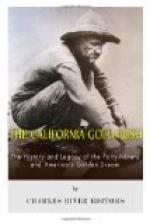Meantime the first emigration from winter quarters was under way, and in the following spring Young conducted a train of eight hundred wagons across the plains to the great valley where a city of adobe and log houses was already building. The new city was laid off into numbered lots. The Presidency had charge of the distribution of these lots. You may be sure they did not reserve the worst for their use, nor did they place about themselves undesirable neighbors. Immediately after the assignments had been made, various people began at once to speculate in buying and selling according to the location. The spiritual power immediately anathematized this. No one was permitted to trade over property. Any sales were made on a basis of the first cost plus the value of the improvement. A community admirable in almost every way was improvised as though by magic. Among themselves the Mormons were sober, industrious, God-fearing, peaceful. Their difficulties with the nation were yet to come.
Throughout the year, 1848, the weather was propitious for ploughing and sowing. Before the crops could be gathered, however, provisions ran so low that the large community was in actual danger of starvation. Men were reduced to eating skins of slaughtered animals, the raw hides from the roofs of houses, and even a wild root dug by the miserable Ute Indians. To cap the climax, when finally the crops ripened, they were attacked by an army of crickets that threatened to destroy them utterly. Prayers of desperation were miraculously answered by a flight of white sea-gulls that destroyed the invader and saved the crop. Since then this miracle has been many times repeated.
It was in August, 1849, that the first gold rush began. Some of Brannan’s company from California had already arrived with samples of gold-dust. Brigham Young was too shrewd not to discourage all mining desires on the part of his people, and he managed to hold them. The Mormons never did indulge in gold-mining. But the samples served to inflame the ardor of the immigrants from the east. Their one desire at once became to lighten their loads so that they could get to the diggings in the shortest possible time. Then the Mormons began to reap their harvest. Animals worth only twenty-five or thirty dollars would bring two hundred dollars in exchange for goods brought in by the travelers. For a light wagon the immigrants did not hesitate to offer three or four heavy ones, and sometimes a yoke of oxen to boot. Such very desirable things to a new community as sheeting, or spades and shovels, since the miners were overstocked, could be had for almost nothing. Indeed, everything, except coffee and sugar, was about half the wholesale rate in the East. The profit to the Mormons from this migration was even greater in 1850. The gold-seeker sometimes paid as high as a dollar a pound for flour; and, conversely, as many of the wayfarers started out with heavy loads of mining machinery and




